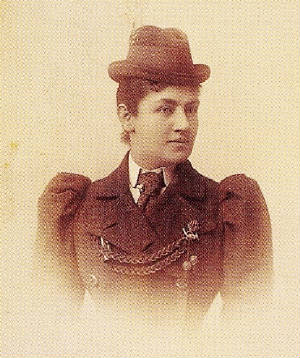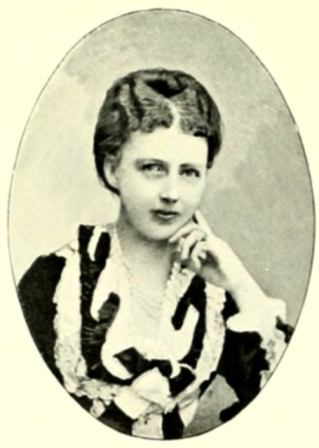Charlotte of Schaumburg-Lippe
Charlotte, Princess of Schaumburg -Lippe (full name: Charlotte Marie Ida Luise Hermine Mathilde ) ( born October 10, 1864 in Castle Ratiborice, Bohemia, † July 16, 1946 in Castle Bebenhausen, Württemberg ) was a member of the House of Schaumburg-Lippe and 1891 to 1918, the last queen of Württemberg.
Life
Origin
Princess Charlotte was the eldest daughter of Prince Wilhelm of Schaumburg -Lippe (1834-1906), youngest son of Prince Georg of Schaumburg -Lippe and Princess Bathildis of Anhalt-Dessau ( 1837-1902 ).
Together with four brothers and three sisters, Charlotte grew up in Bohemia in the princely rule Náchod. In addition to interests such as music and the visual arts she apparently harbored also sports such as swimming, tennis, cycling, and - for a woman of that time still unusual - skiing. As a failed was also their passion for hunting.
The marriage of the house of Schaumburg-Lippe with Württemberg
On April 8, 1886 married Princess Charlotte in Biickeburg, the residence of her uncle Adolf, Crown Prince Wilhelm of Württemberg, who ascended the throne in 1891 as King William II of Württemberg. She was his second wife and was in Württemberg, as well as its predecessor Marie of Waldeck and Pyrmont, as politically insignificant game. Should marriage be done for reasons of state policy - it lacked a male child - so this calculation did not work out, because the marriage remained childless.
As Württemberg Princess they initially lived in Ludwigsburg and Stuttgart, as Queen Wilhelmspalais in Stuttgart. During the months of June to October, the royal couple moved his residence to Friedrichshafen. In November / December, finally, William and Charlotte spent a regular two-week stay in the hunting lodge hunting Bebenhausen at Tübingen. After the revolution of 1918 Bebenhausen should be the permanent home and estates of former Queen, later to become Duchess Charlotte.
Charlotte's years as Queen of Württemberg
While King William II enjoyed great popularity among his contemporaries, Charlotte's relationship to the Wurttembergers seems to be rather been a reserved. This is Conspicuous in contemporary publications, which are characterized by exuberance against the king and a marked reluctance towards the Queen. Childlessness may have been a reason for this, but it is insufficient as an explanation for the contemporary aloofness. Another reason seems to lie in that Charlotte was not ready to meet their courtly ceremonial duties in the expected extent. Your birthdays celebrated example rather in the seclusion of Friedrichshafen as conspicuously solidarity with the population. Military parades she left the king alone and usually decrease to the Emperor 's birthday, she accompanied her husband after a few years as queen no more.
But Charlotte was not only the Queen, who was engaged in a very unconventional approach to the representation, but she was also the monarch to the developments of the modern showed an open mind. This is illustrated by its Social Engagement. The following conventions, she took alone from their predecessors 32 protectorates on social and charitable institutions. Among many other included the deaconesses essence, the Swabian Women's Association, the Central line for charity, the Württemberg Savings Bank and the Red Cross to do so. The sponsorship, which she took over as the Queen personally, think of special interest to the " make myself independent of womankind ," as it was called, a contemporary observer, on. Of course, Charlotte committed not personally involved in the women's movement, but they signaled accordance with its objectives, by taking over protectorates for institutions that had the improvement of female concerns in mind. With her authority as Queen Charlotte supported educational institutions in particular, in which girls should be trained to self- employment. Especially her female political involvement in sponsorship of the Württemberg painters club and for the first Württemberg humanistic grammar school for girls, the Stuttgart- Charlotte High School (now Hölderlin -Gymnasium ) showed.
Support for the painters club already indicated to another area of interest Charlottes, the field of art and culture. Together with her husband she took an active part in cultural life, with their very special care of the opera and the theater was.
After the end of the monarchy in Württemberg
Upon his abdication Wilhelm II had agreed with the State of Württemberg for himself and his wife a lifetime right to live in Bebenhausen castle and an annual pension. In addition to state Apanage Charlotte received from the Ducal Court Chamber a grant for the royal household. After the death of her husband in 1921, Charlotte lived as a Duchess of Württemberg still twenty-five years retired in Bebenhausen. In 1944 she suffered a stroke, which forced her to spend the last two years of her life in a wheelchair.
Queen Charlotte died on 16 July 1946 at the age of 81 years in Bebenhausen. With her died not only the last Württemberg queen, she was also the last German Queen, after her 1921 were preceded in death the Queen of Saxony in 1907, the Queen of Bavaria in 1919 and the German Empress and Queen of Prussia. She was born on July 23, 1946, almost unnoticed by the public, buried in the Old Cemetery in Ludwigsburg at her husband's side.










